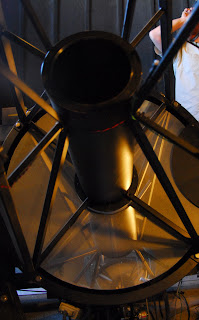Progress on RSS was halted late yesterday when a power supply blew. Fortunately we had a spare so it shouldn't have been a big deal.
However, it happens to live in an awfully inaccessible place in one of the electronics crates so Peter had significantly more fun than he needed, trying to get at the screws in order to remove it.
The new power supply has extra fuses onboard which will save a lot of hassle in future, but Pete modified things anyway to ensure that it'd be easier to replace if this happens again.
We had some very special visitors up here today... After a particularly good Thursday morning tea in the hostel (Happy Birthday Johan!), the ladies came up for a tour of the spectrometer room to see what all the fuss is about.
Chief Tour Guide Chris showed them all around & extra input was provided by the SALTICAM & RSS instrument PIs (Darragh & Ken respectively). Darragh even showed off his ever-increasing Afrikaans repertoire!
Ken still has a way to go in that department, but seeing as we'll have him up here for a couple of months, we'll see what can be done to get him to "praat die taal"...
Over on the payload, BVIT (the Berkeley Visible Image Tube) went back in & was connected up, even though its shutter has yet to be repaired. The BVIT guys will have to come out & fix that once SALT's back in business.
Up on the tracker - the last of the hexapod pins were replaced & then it was time to grease the X, Y & Rho slides.
Since some of the new people at SALT are unfamiliar with the rest of the facilities here at the observatory, a tour was in order. John Stoffels & Piet Fourie kindly offered their time to show us around - thanks guys!
Piet pointed out the equipment involved in experiments for monitoring the soil moisture & groundwater, then took us in to see the South African Geodynamic Observatory's 2 superconducting gravimeters. These Incredible instruments are cooled with liquid helium to a temperature of 4.2 K (nearly -270 C!) & can measure variations in gravity to one thousandth of one billionth of the Earth's surface gravity. WOW...
Then John took us in to see a few of the small telescopes - including the Alan Cousins Telescope (ACT), a 0.75-m automatic photometric telescope.
SuperWASP-South (Super Wide Angle Search for Planets) - the second of Keele University's robotic facilities for finding exoplanets. This is done by observing transits, dips in a star's light curve due to a planet passing in front of the star & obscuring some of its light. To date, the SuperWASP team's found nearly 30 of these planetary systems.
We also visited the Japanese 1.4-m Infrared Survey Facility (IRSF) which carries a near infrared polarimeter & a camera that simultaneously images in the J, H & K near infrared bands.
While exploring the IRSF, The Boss (Chris) insisted on borrowing my camera so that a photo of me could be included in the blog - Mom, I presume you put him up to this?! Anyway - Hello Everyone :)
Last stop before dinner was the delightful 1.0-m telescope (many many happy weeks spent observing on this one!). Here we see Amanda earning her telescope pointing badge...
Great stuff - fun day all round :)















No comments:
Post a Comment